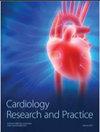经皮冠状动脉介入治疗st段抬高型心肌梗死患者无血流再流的危险因素:一项病例-对照研究
IF 1.8
4区 医学
Q3 CARDIAC & CARDIOVASCULAR SYSTEMS
引用次数: 2
摘要
方法回顾性分析2010年1月至2013年1月北京安贞医院心内科STEMI发病后12 h内经皮冠状动脉介入治疗的患者资料。结果共纳入902例患者。除了入院时间、心率、血糖、高敏c反应蛋白(hsCRP)/前白蛋白(PAB)、中性粒细胞计数、主动脉内球囊泵和吸入性取栓外,回流组和非回流组的基本特征相似。多变量分析显示:hsCRP/PAB (OR = 1.003, 95% CI: 1.000 ~ 1.006, P=0.022)、中性粒细胞计数(OR = 1.085, 95% CI: 1.028 ~ 1.146, P=0.003)、血浆葡萄糖水平(OR = 1.086, 95% CI: 1.036 ~ 1.138, P=0.001)、糖尿病(OR = 0.596, 95% CI: 0.371 ~ 0.958, P=0.033)、Killip分级>1 (OR = 2.002, 95% CI: 1.273 ~ 3.148, P=0.003)、术中使用主动脉内球囊泵(OR = 3.257, 95% CI: 1.954 ~ 5.428, P=0.001)、吸入性取栓(OR = 3.412, 95% CI: P=0.003)。2.259-5.152, P=0.001)与无回流独立相关。结论hsCRP/PAB、中性粒细胞计数、血糖水平、糖尿病、Killip分型、术中使用IABP、吸入性取栓是STEMI患者无再流的独立危险因素。本文章由计算机程序翻译,如有差异,请以英文原文为准。
Risk Factors for No-Reflow in Patients with ST-Elevation Myocardial Infarction Who Underwent Percutaneous Coronary Intervention: A Case-Control Study
Methods This case-control study retrospectively reviewed the medical data of patients treated with primary percutaneous coronary intervention within 12 h after STEMI onset between January 2010 and January 2013 at the Department of Cardiology of the Beijing Anzhen Hospital. Results A total of 902 patients were included in the analysis. The basic characteristics between the reflow and no-reflow groups were similar, except for time-to-hospital admission, heart rate, plasma glucose, high-sensitivity C-reactive protein (hsCRP)/prealbumin (PAB), neutrophil count, intraaortic balloon pump, and aspiration thrombectomy. The multivariable analysis showed that hsCRP/PAB (OR = 1.003, 95% CI: 1.000–1.006, P=0.022), neutrophil count (OR = 1.085, 95% CI: 1.028–1.146, P=0.003), plasma glucose levels (OR = 1.086, 95% CI: 1.036–1.138, P=0.001), diabetes mellitus (OR = 0.596, 95% CI: 0.371–0.958, P=0.033), Killip classification >1 (OR = 2.002, 95% CI: 1.273–3.148, P=0.003), intraoperative intraaortic balloon pump (IABP) use (OR = 3.257, 95% CI: 1.954–5.428, P=0.001), and aspiration thrombectomy (OR = 3.412, 95% CI: 2.259–5.152, P=0.001) were independently associated with no-reflow. Conclusion hsCRP/PAB, neutrophil count, plasma glucose levels, diabetes mellitus, Killip classification, intraoperative IABP use, and aspiration thrombectomy were independent risk factors for no-reflow in patients with STEMI.
求助全文
通过发布文献求助,成功后即可免费获取论文全文。
去求助
来源期刊

Cardiology Research and Practice
Medicine-Cardiology and Cardiovascular Medicine
CiteScore
4.40
自引率
0.00%
发文量
64
审稿时长
13 weeks
期刊介绍:
Cardiology Research and Practice is a peer-reviewed, Open Access journal that publishes original research articles, review articles, and clinical studies that focus on the diagnosis and treatment of cardiovascular disease. The journal welcomes submissions related to systemic hypertension, arrhythmia, congestive heart failure, valvular heart disease, vascular disease, congenital heart disease, and cardiomyopathy.
 求助内容:
求助内容: 应助结果提醒方式:
应助结果提醒方式:


